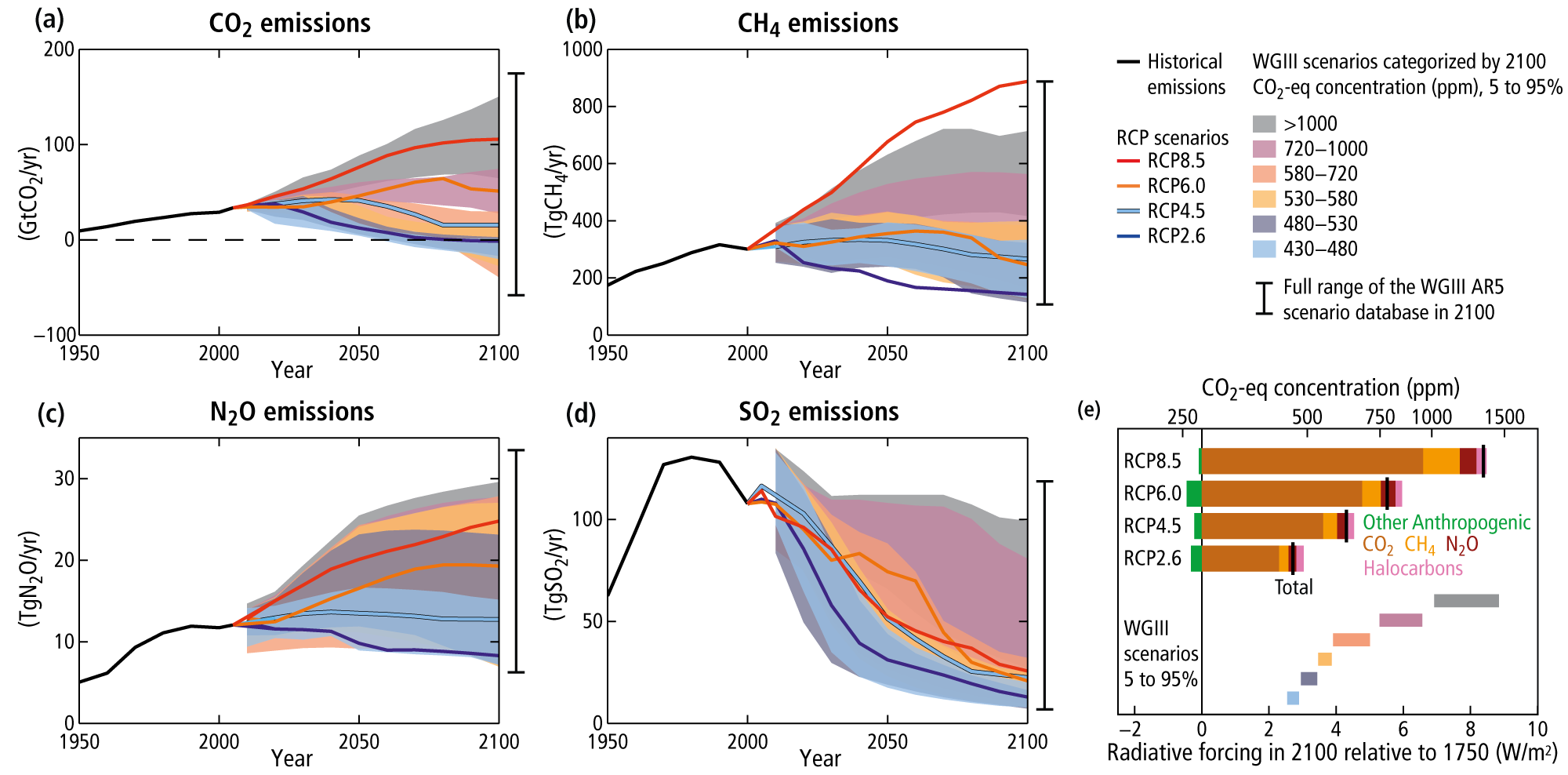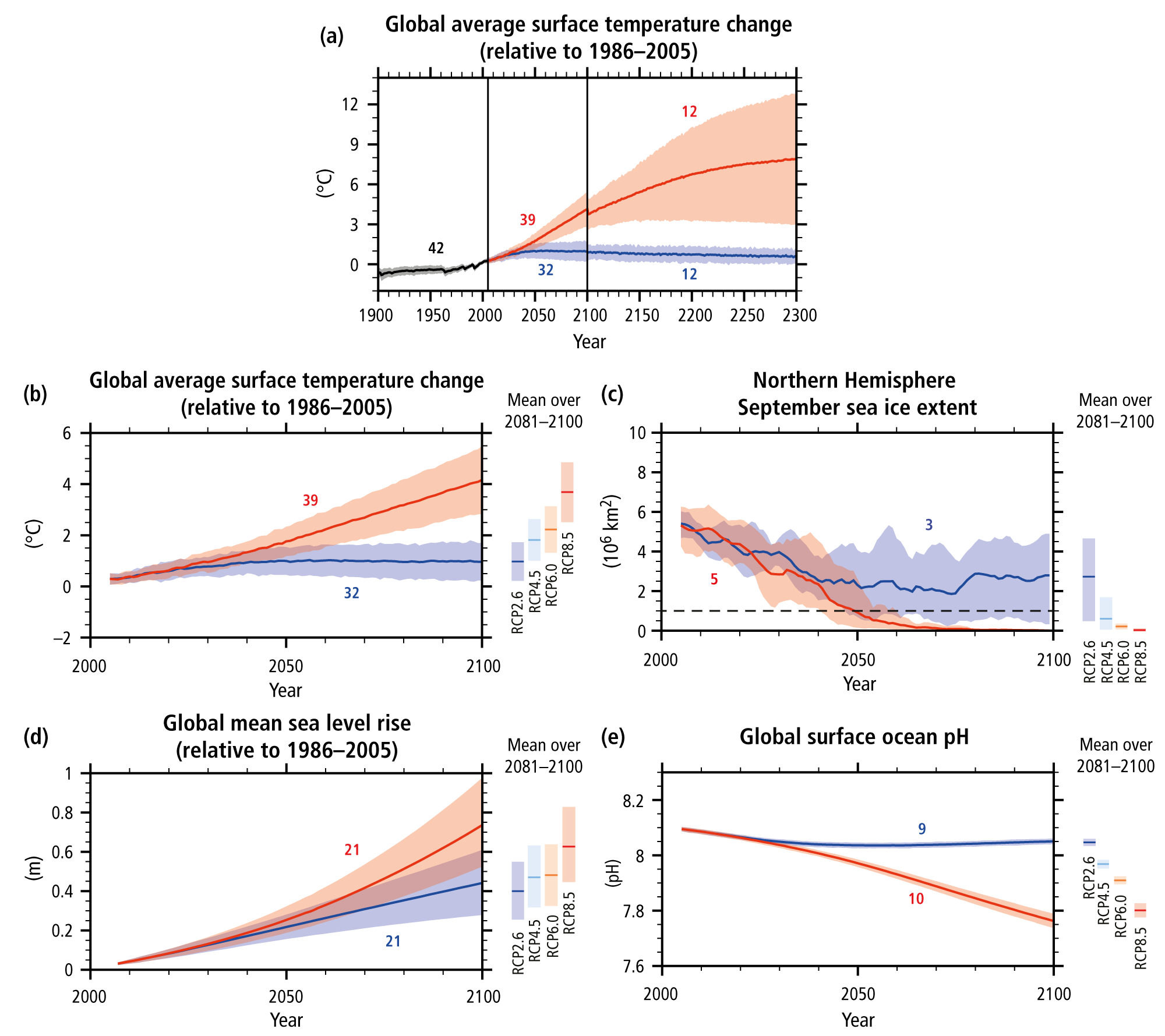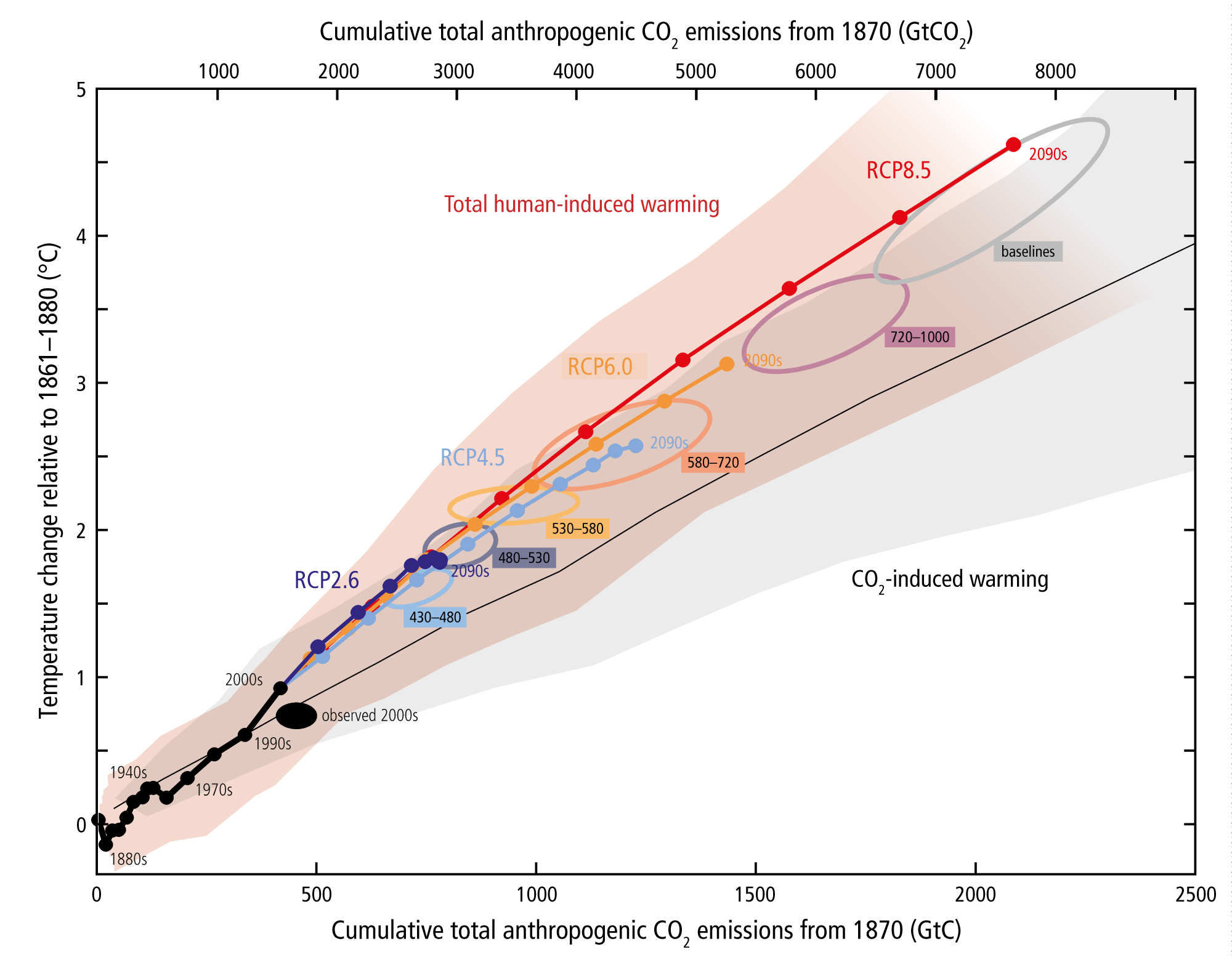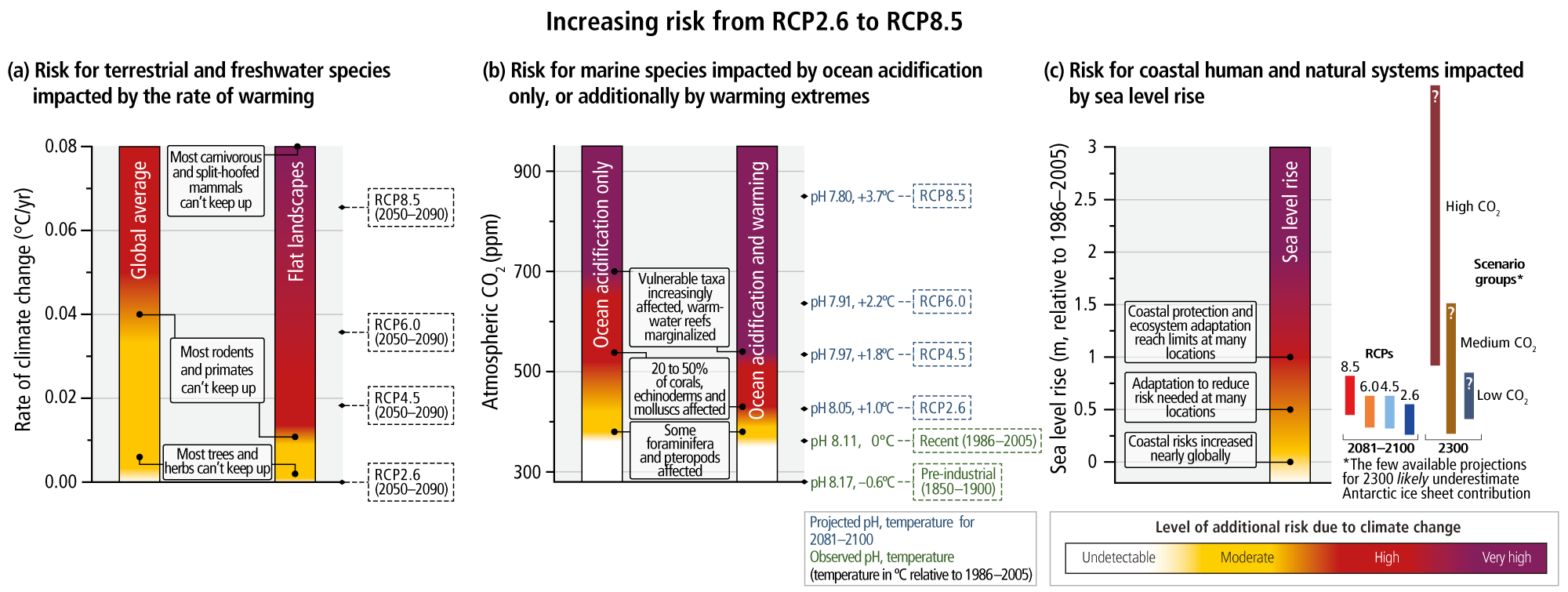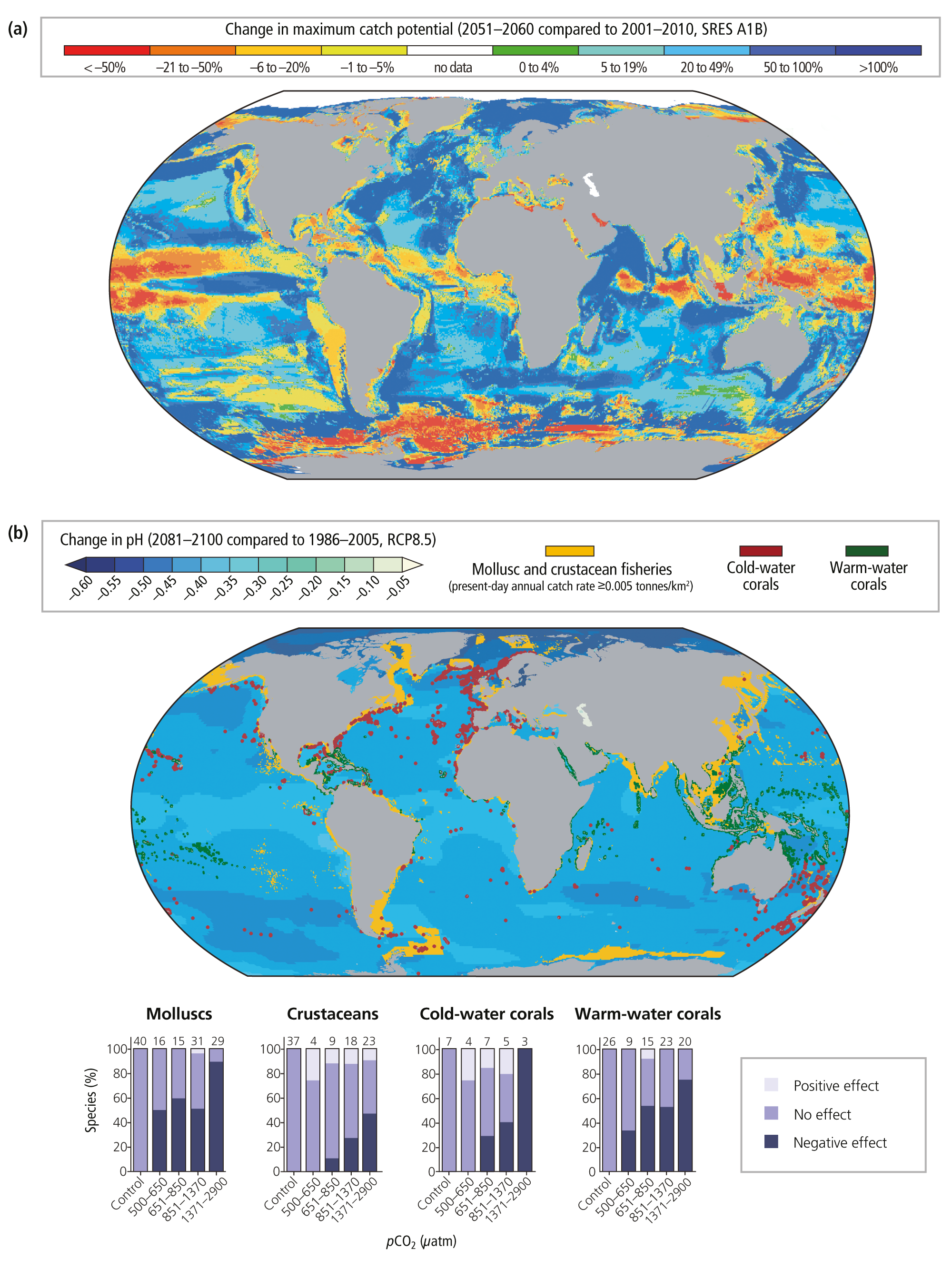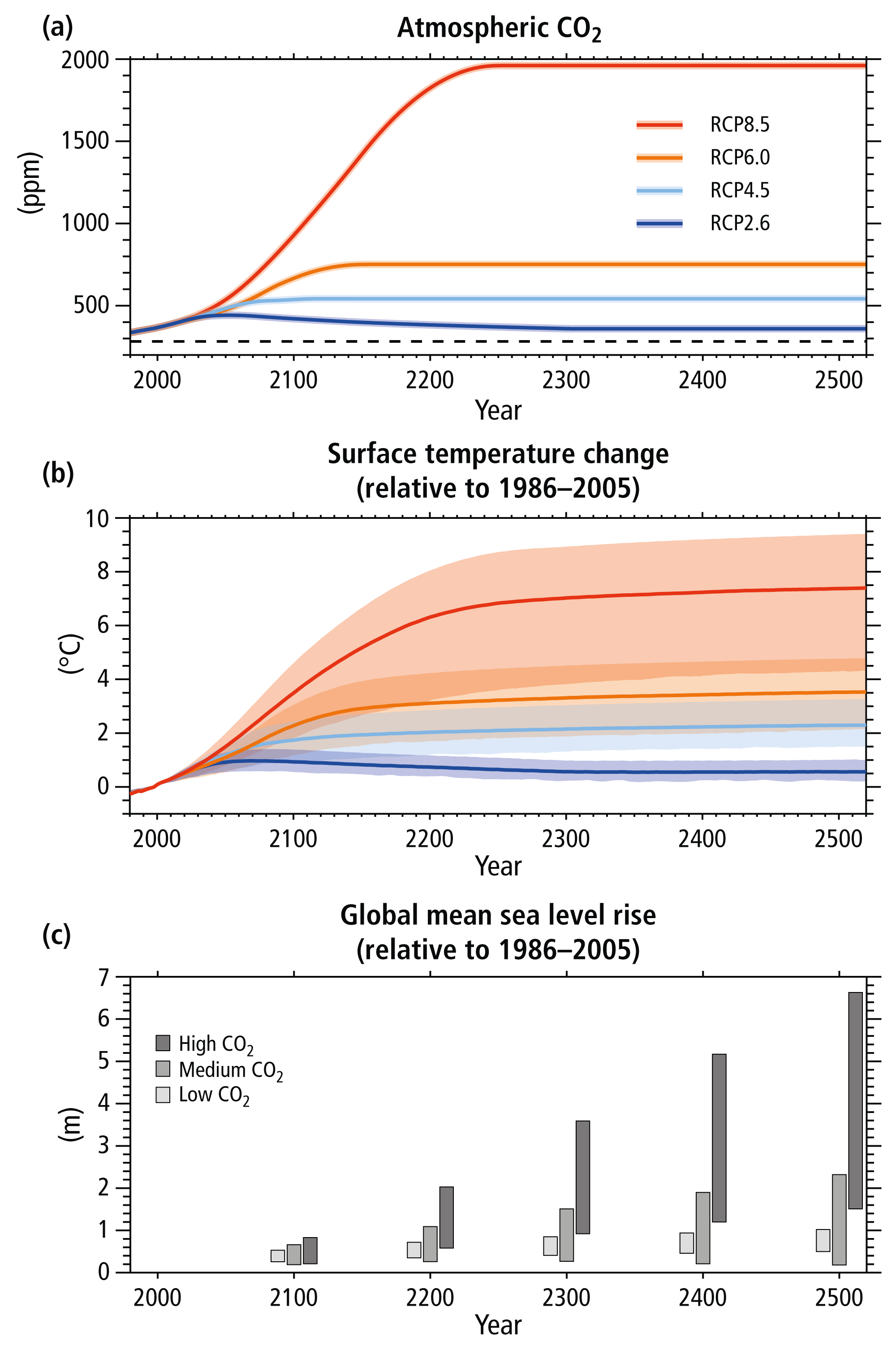Climate models are mathematical representations of processes important in the Earth’s climate system. Results from a hierarchy of climate models are considered in this report; ranging from simple idealized models, to models of intermediate complexity, to comprehensive General Circulation Models (GCMs), including Earth System Models (ESMs) that also simulate the carbon cycle. The GCMs simulate many climate aspects, including the temperature of the atmosphere and the oceans, precipitation, winds, clouds, ocean currents, and sea-ice extent. The models are extensively tested against historical observations (Box 2.1). {WGI 1.5.2, 9.1.2, 9.2, 9.8.1}
In order to obtain climate change projections, the climate models use information described in scenarios of GHG and air pollutant emissions and land use patterns. Scenarios are generated by a range of approaches, from simple idealised experiments to Integrated Assessment Models (IAMs, see Glossary). Key factors driving changes in anthropogenic GHG emissions are economic and population growth, lifestyle and behavioural changes, associated changes in energy use and land use, technology and climate policy, which are fundamentally uncertain. {WGI 11.3, 12.4, WGIII 5, 6, 6.1}
Box 2.1 Advances, confidence and uncertainty in modelling the Earth’s climate system
EditImprovements in climate models since the IPCC Fourth Assessment Report (AR4) are evident in simulations of continental-scale surface temperature, large-scale precipitation, the monsoon, Arctic sea ice, ocean heat content, some extreme events, the carbon cycle, atmospheric chemistry and aerosols, the effects of stratospheric ozone and the El Niño-Southern Oscillation. Climate models reproduce the observed continental-scale surface temperature patterns and multi-decadal trends, including the more rapid warming since the mid-20th century and the cooling immediately following large volcanic eruptions (very high confidence). The simulation of large-scale patterns of precipitation has improved somewhat since the AR4, although models continue to perform less well for precipitation than for surface temperature. Confidence in the representation of processes involving clouds and aerosols remains low. {WGI SPM D.1, 7.2.3, 7.3.3, 7.6.2, 9.4, 9.5, 9.8, 10.3.1}
The ability to simulate ocean thermal expansion, glaciers and ice sheets, and thus sea level, has improved since the AR4, but significant challenges remain in representing the dynamics of the Greenland and Antarctic ice sheets. This, together with advances in scientific understanding and capability, has resulted in improved sea level projections in this report, compared with the AR4. {WGI SPM E.6, 9.1.3, 9.2, 9.4.2, 9.6, 9.8, 13.1, 13.4, 13.5}
There is overall consistency between the projections from climate models in AR4 and AR5 for large-scale patterns of change and the magnitude of the uncertainty has not changed significantly, but new experiments and studies have led to a more complete and rigorous characterization of the uncertainty in long-term projections. {WGI 12.4}
The standard set of scenarios used in the AR5 is called Representative Concentration Pathways (RCPs, Box 2.2). {WGI Box SPM.1}
Box 2.2 The Representative Concentration Pathways (RCPs)
EditThe Representative Concentration Pathways (RCPs) describe four different 21st century pathways of greenhouse gas (GHG) emissions and atmospheric concentrations, air pollutant emissions and land use. The RCPs have been developed using Integrated Assessment Models (IAMs) as input to a wide range of climate model simulations to project their consequences for the climate system. These climate projections, in turn, are used for impacts and adaptation assessment. The RCPs are consistent with the wide range of scenarios in the mitigation literature assessed by WGIII1The scenarios are used to assess the costs associated with emission reductions consistent with particular concentration pathways. The RCPs represent the range of GHG emissions in the wider literature well (Box 2.2, Figure 1); they include a stringent mitigation scenario (RCP2.6), two intermediate scenarios (RCP4.5 and RCP6.0), and one scenario with very high GHG emissions (RCP8.5). Scenarios without additional efforts to constrain emissions (‘baseline scenarios’) lead to pathways ranging between RCP6.0 and RCP8.5. RCP2.6 is representative of a scenario that aims to keep global warming likely below 2°C above pre-industrial temperatures. The majority of models indicate that scenarios meeting forcing levels similar to RCP2.6 are characterized by substantial net negative emissions2 by 2100, on average around 2 GtCO2/yr. The land use scenarios of RCPs, together, show a wide range of possible futures, ranging from a net reforestation to further deforestation, consistent with projections in the full scenario literature. For air pollutants such as sulfur dioxide (SO2), the RCP scenarios assume a consistent decrease in emissions as a consequence of assumed air pollution control and GHG mitigation policy (Box 2.2, Figure 1). Importantly, these future scenarios do not account for possible changes in natural forcings (e.g. volcanic eruptions) (see Box 1.1). {WGI Box SPM 1, 6.4, 8.5.3, 12.3, Annex II, WGII 19, 21, WGIII 6.3.2, 6.3.6}
The RCPs cover a wider range than the scenarios from the Special Report on Emissions Scenarios (SRES) used in previous assessments, as they also represent scenarios with climate policy. In terms of overall forcing, RCP8.5 is broadly comparable to the SRES A2/A1FI scenario, RCP6.0 to B2 and RCP4.5 to B1. For RCP2.6, there is no equivalent scenario in SRES. As a result, the differences in the magnitude of AR4 and AR5 climate projections are largely due to the inclusion of the wider range of emissions assessed. {WGI TS Box TS.6, 12.4.9}
Box 2.2, Figure 1 | Emission scenarios and the resulting radiative forcing levels for the Representative Concentration Pathways (RCPs, lines) and the associated scenarios categories used in WGIII (coloured areas, see Table 3.1). Panels a to d show the emissions of carbon dioxide (CO2), methane (CH4), nitrous oxide (N2O) and sulfur dioxide (SO2). Panel e shows future radiative forcing levels for the RCPs calculated using the simple carbon cycle climate model, Model for the Assessment of Greenhouse Gas Induced Climate Change (MAGICC), for the RCPs (per forcing agent) and for the WGIII scenario categories (total) {WGI 8.2.2, 8.5.3, Figure 8.2, Annex II, WGIII Table SPM.1, Table 6.3}. The WGIII scenario categories summarize the wide range of emission scenarios published in the scientific literature and are defined based on total CO2-equivalent concentrations (in ppm) in 2100 (Table 3.1). The vertical lines to the right of the panels (panel a–d) indicate the full range of the WGIII AR5 scenario database.
The methods used to estimate future impacts and risks resulting from climate change are described in Box 2.3. Modelled future impacts assessed in this report are generally based on climate-model projections using the RCPs, and in some cases, the older Special Report on Emissions Scenarios (SRES). {WGI Box SPM.1, WGII 1.1, 1.3, 2.2-2.3, 19.6, 20.2, 21.3, 21.5, 26.2, Box CC-RC}
Risk of climate-related impacts results from the interaction between climate-related hazards (including hazardous events and trends) and the vulnerability and exposure of human and natural systems. Alternative development paths influence risk by changing the likelihood of climatic events and trends, through their effects on GHGs, pollutants and land use, and by altering vulnerability and exposure. {WGII SPM, 19.2.4, Figure 19-1, Box 19-2}
Experiments, observations and models used to estimate future impacts and risks have improved since the AR4, with increasing understanding across sectors and regions. For example, an improved knowledge base has enabled expanded assessment of risks for human security and livelihoods and for the oceans. For some aspects of climate change and climate change impacts, uncertainty about future outcomes has narrowed. For others, uncertainty will persist. Some of the persistent uncertainties are grounded in the mechanisms that control the magnitude and pace of climate change. Others emerge from potentially complex interactions between the changing climate and the underlying vulnerability and exposure of people, societies and ecosystems. The combination of persistent uncertainty in key mechanisms plus the prospect of complex interactions motivates a focus on risk in this report. Because risk involves both probability and consequence, it is important to consider the full range of possible outcomes, including low-probability, high-consequence impacts that are difficult to simulate. {WGII 2.1-2.4, 3.6, 4.3, 11.3, 12.6, 19.2, 19.6, 21.3-21.5, 22.4, 25.3-25.4, 25.11, 26.2}
Edit